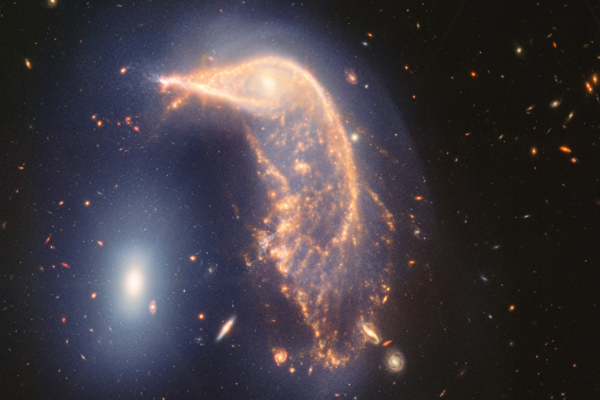The James Webb Space Telescope (JWST) has captured another astonishing discovery as it marks two years into operation: two galaxies in the cosmos dancing gracefully, resembling a penguin guarding an egg, intertwined in a bond that is hard to break.
The Webb Telescope was launched on December 25, 2021, and conducted its first scientific observations of the universe on July 12, 2022. This cutting-edge observatory observes the universe in infrared wavelengths invisible to the human eye. It has the unprecedented sharpness to penetrate previously obscured gas and dust, unveiling distant galaxies.
According to a statement by Bill Nelson, the Administrator of the National Aeronautics and Space Administration (NASA), the Webb Telescope has captured extraordinary images from various corners of the universe.
Using its scientific instruments, the Webb Telescope has now produced a detailed image of the Arp 142 galaxy located in the Hydra constellation, approximately 326 million light-years away from Earth, through observations in near-infrared and mid-infrared light. It actually consists of two galaxies, where one appears like a penguin guarding another egg-shaped galaxy. While the “egg” looks intact and undisturbed in their dance, the penguin shows signs of disruption.
The Hubble Space Telescope captured an image of this galaxy pair in visible light in 2013, but the Webb Telescope has revealed never-before-seen details through infrared imaging.
These two galaxies are about 100,000 light-years apart, which is relatively close in astronomical terms. For comparison, the closest neighbor of the Milky Way is the Andromeda Galaxy, located 2.5 million light-years away. One light-year equals 5.88 trillion miles (9.46 trillion kilometers), the distance light travels in one year.
Astronomers estimate that the interaction between the penguin and egg galaxies occurred around 25 to 75 million years ago. Since then, they have remained together, slowly interacting with each other.
The faint blue haze (a mixture of stars and gas) observed by the Webb Telescope in near-infrared and mid-infrared links these two galaxies together.
In hundreds of millions of years, they will merge into a single galaxy.
Before their first close encounter, the penguin galaxy was originally spiral-shaped. However, over time, it has transformed through its interaction with the egg galaxy. Now, the center of the galaxy has become the penguin’s eye, while its spiral arms have loosened to form the penguin’s beak, head, back, and fan-shaped tail.
This transformation is due to gravitational forces acting on parts of the penguin galaxy from the interaction with the egg galaxy, causing collisions of gas and dust, triggering significant star formation.
Meanwhile, the elliptical egg galaxy under the penguin’s “guardianship” has shown minimal changes. This galaxy is filled with aging stars and contains less gas and dust compared to the penguin galaxy, retaining its structure undisturbed. Another reason is that the mass or weight of the two galaxies is roughly similar, preventing the smaller egg from being consumed or distorted by the penguin.

